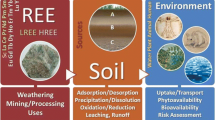Abstract
The Ankang black shales in P. R. of China provides an important example of natural geological materials containing toxic elements. This paper presents the results of environmental geochemical research on black shales, soils, waters and edible plants in the Ankang area, Shaanxi Province, P. R. of China. The study area lies in the northern margin of the Yangtze Platform; there are black shales which contains black shale, carbonaceous rocks and coal in the Cambrian Donghe Formation throughout the area. Mean trace element concentrations of the coal were high. Soils derived from these rocks tend to reflect their extreme geochemical composition. Chemical analysis of common plant species in the Ankang area showed a heterogeneous distribution of Se, Mo, and V within a single and among plant species. Selenium was more concentrated in radish than in legumes, and in potato more than in green vegetable. High V concentrations were found in two kinds of Chinese tea. Legume had more Mo in the seed than potato, although Mo concentrations in radish vary. Higher concentrations of Se and Mo are present in the leaf of radish.
Similar content being viewed by others
References
Äyräs, M., Niskavaara, H., Bogatyrev, I., Chekushin, V., Pavlov, V., de Caritat, P., Halleraker, J.H., Finne, T.E., Kashulina, G. and Reimann, C.: 1997, Regional pattern of heavy metals (Co, Cr, Cu, Fe, Ni, Pb, V and Zn) and sulfur in terrestrial moss sample as indication of airbome pollution in a 188,000 km2 area in northern Finland, Norway and Russia, Journal of Geochemical Exploration 58(2-3), 269–281.
Baker, D.E. and Bowers, M.E.: 1989, Human Health Effects of Cadmium Predicted from Growth and Composition of Lettuce in Gardens Contaminated by Emissions from Zinc Smelters, in: D.D. Hemphill (ed.) Trace Substances in Environmental Health-XXII, University of Missouri, Columbia, pp. 281–295.
Cheng, L.B., Mei, Z.Q. and Huang, L.F.: 1991, Investigation on the selenium contents in Ziyang Tea, Shaanxi Province, China (in Chinese with English abstract), Journal of Tea Science 11(1), 63–66.
Dunn, C.E., Brooks, R.R., Edmondson, J., Leblance, M. and Reeves, R.D.: 1996, Biogeochemical studies of metal-tolerant plants from southern Morocco, Journal of Geochemical Exploration 56(1), 13–22.
Fang, W. X., Wu, P.W. and Li X.F.: 1996, Ecogeochemical Research In Ankang Area, Shaanxi Province, China, 30th International Geological Congress Abstracts, Vol. 3(3), 12-4-3, p. 44.
Fang, W.X., Wu, P.W., Zuo, J.L. and Li, X.F.: 1995, Environmental geochemical research and suggestion on the ecological agriculture in the Ankang area, Shaanxi Province (in Chinese with English abstract), Geological Exploration for Non-ferrous Metals 4(5), 311–315.
Fang, W.X., Wu, P.W. and Zuo, J.L.: 1996, Trace element contents of Amorphophallus Konjac. Koch and planting experiment (in Chinese with English abstract), Geological Exploration for Nonferrous Metals 5(3), 180–183.
Fernandez-Turiel, J.L., Acenolaza, P., Medina, M.E., Llorens, J.F. and Sardi, F.: 2001, Assessment of a smelter impact area using surface soils and plants, Environmental Geochemistry and Health 23, 65–78.
Foth, H.D.: 1978, Fundamentals of Soil Science, 4th edn, Wiley, New York.
Frost. D.V.: 1967, Significance of the Symposium, in: O.H. Muth (ed.) Symposium on Selenium and Biomedicine, Avi. Publ. Co., Westport, Conn.
Kyoung-Woong Kim and Iain Thornton: 1993, Influence of uraniferous black shales on cadmium, molybdenum and selenium in soils and crop plants in the Deog-Pyoung area of Korea, Environmental Geochemistry and Health 15(2/3), 119–133.
Kim, K.W.: 1989, Geochemistry and genesis of the Guryongsan (Ogcheon) uraniferous black slates, Journal of the Korean Institute of Mining Geology 22, 35–63.
Jin-Soo Lee, Hyo-Taek Chon, Jong-Shin Kim, Kyoung-Woong Kim and Hi-Soo Moon: 1998, Enrichment of potentially toxic elements in areas underlain by black shales and slates in Korea, Environmental Geochemistry and Health 20, 135–147.
Lakin, H.K.: 1972, Selenium accumulation in soils and its absorption by plants and animals, Geological Society of American Bulletin 83(181).
Langedal, M.: 1997, Dispersion of tailings in the Kanbeåna-Kvina drainage basin, Norway, 2: mobility of Cu and Mo in tailings-derived fluvial sediments, Journal of Geochemical Exploration 58(2-3), 173–183.
Lund, L.J., Betty, E.E., Page, A.L. and Elliott, R.A.: 1981, Occurrence of naturally high cadmium levels in soils and its accumulation by vegetation, Journal of Environmental Quality 10, 551–556.
Wong, M.H., Zhang, Z.Q., Wong, J.W.C. and Lan, C.Y.: 1998, Trace metal contents (Al, Cu and Zn) of tea: tea and soil from two tea plantation, and tea products from different provinces of China, Environmental Geochemistry and Health 20, 87–94.
Mattigod, S.V. and Page, A.L.: 1983, Assessment of metal pollution in soils; effects on yield cadmium uptake by lettuce and chard, Journal of Environmental Quality 7, 274–281.
Paton, A. and Brooks, R.R.: 1996, A re-evaluation of Humaniastrum species as geobotanical indicators of copper and cobalt. Journal of Geochemical Exploration 56(1), 37–45.
Robinson, B.H., Chiarucci, A., Brook, R.R., Petit, D., Kirkman, J.H., Gregg, P.E.H. and De Dominicis V.: 1997, The nickel hyperaccumulator plant Alyssum bertolonili as a potential agent for phytoremediation and phytomining of nickel, Journal of Geochemical Exploration 59(2), 75–86.
Thompson, M. and Zao. L.: 1985, Rapid determination of molybdenum in soils with inductively coupled plasma atomic emission spectrometry, Analyst 110, 229–235.
Thornton, I.: 1993, Geochemistry applied to agriculture, in: I. Thornton (ed.) Applied Environmental Geochemistry, Academic Press, London, pp. 231–266.
Vine, J.D.: 1969, Element distribution in some Paleozoic black shales and associated rocks, United States Geological Survey Bulletin 1214, 1–32.
Vine, J.D. and Tourtelot, E.B.: 1970, Geochemistry of black shale deposit - a summary report, Economic Geology 65, 253–272.
Zhang, A.Y., Wu, D.M., Guo, L. and Wang, Y.L.: 1987, The geochemistry of marine black shale formation and its metallogenic signature (in Chinese with English abstract), pp. 1–55.
Maksimovic, Z., Jovic, V., Djujic, I. and Rsumovic, M.: 1992, Selenium deficiency in Yugoslvia and possible effects on health, Environmental Geochemistry and Health 14(4), 107–111.
Author information
Authors and Affiliations
Corresponding author
Rights and permissions
About this article
Cite this article
Fang, W., Hu, R. & Wu, P. Influence of Black Shales on Soils and Edible Plants in the Ankang Area, Shaanxi Province, P. R. of China. Environmental Geochemistry and Health 24, 35–46 (2002). https://doi.org/10.1023/A:1013981016542
Issue Date:
DOI: https://doi.org/10.1023/A:1013981016542




